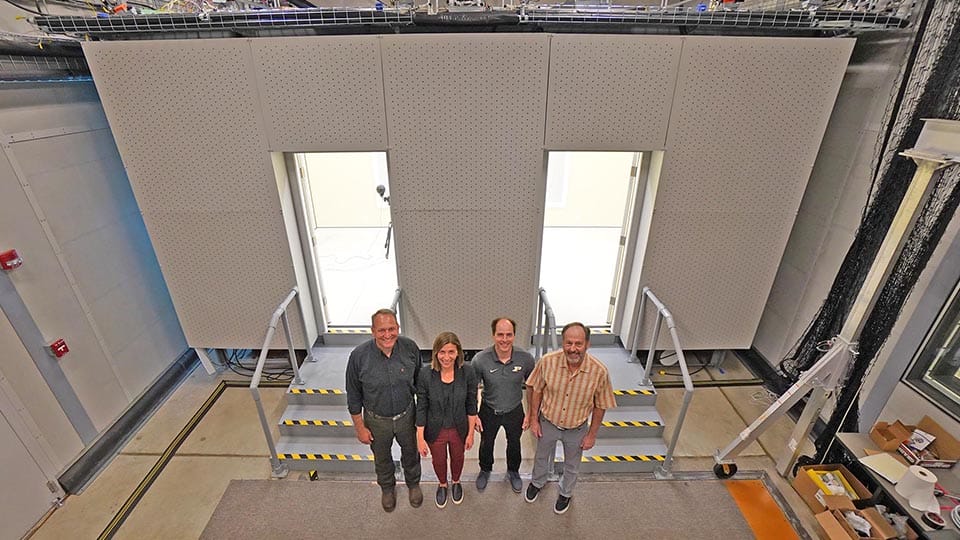Purdue-led partnership seeks to bolster factory-built housing industry
Subscriber Benefit
As a subscriber you can listen to articles at work, in the car, or while you work out. Subscribe Now
Purdue University is leading a coalition of academic partners vying for $160 million in federal funding it says will help establish Indiana and southern Michigan as the “Silicon Valley” for sustainable, cost-effective housing.
The NextHouse initiative aims to leverage the partners’ research and testing capabilities to develop the next generation of factory-built housing.
“We definitely have a long history in the area of factory-built housing,” said Travis Horton, a professor of civil engineering at Purdue. “We think there are opportunities to go far beyond what has been done today and go to a fully industrialized model for housing, much in the way that the automotive industry has done that.”
Purdue has teamed up with the University of Notre Dame, Michigan State University, and the University of Michigan, and the group has already received $1 million from the National Science Foundation to create a proposal to secure the larger grant from the NSF Regional Innovation Engines program.
The team is looking to create a revitalized, fully-automated, and scaled-up factory-built housing industry, Purdue said. Horton added the goal is to address the housing shortage that has gripped the entire country, especially when it comes to affordable housing.
He said while Indiana and Michigan, in particular, are very cost effective places to live, they still remain in the middle of the pack when it comes to access to low-income housing.
Going to a factory-built, industrialized housing model, Horton said, can help address many of those challenges such as labor shortages.
“As soon as we go into a factory, now we have the the opportunity to use robotics, to use automation; we don’t need the typical upper body strength endurance that you typically see in construction workers out on the site because we can take advantage of all of those industrial processes,” he said. “So we broaden the labor participation; the workforce opens up a lot of new opportunities inside of this space.”
Factory-built housing also isn’t constrained by weather, Horton said. The model also allows itself for more customization, something the current manufactured housing industry doesn’t have much of.
“Many of the construction techniques used to build housing in the U.S. haven’t changed since the Industrial Revolution,” James Braun, director of the Center for High Performance Buildings at Purdue, said in written remarks. “We don’t just need more homes—we need better homes that prioritize affordability, sustainability, and resilience. The only way to do that is to change our paradigm of how homes are built.”
To do that, the NextHouse initiative if focusing on several key areas: inspired research, translation to practice, and workforce development.
A main aspect of the research component is the planned prototyping and testing facility on Purdue’s West Lafayette campus. Horton said if the team secures the $160 million award, it will build the facility, which will allow for experimentation of construction techniques for modular housing and serve as a training center for workers.
It will also feature the Housing Environmental Evaluation Testing, or HEET, Lab.
“We’ll have the ability to simulate a full range of temperature conditions, solar conditions, potentially even moisture conditions,” he said. “We’ll have the ability to build a modular home inside of a test facility and then test it at scale, test all of the sub-components, all the systems, all of the new technologies, that would we be built into that.”
The NextHouse team has already begun some of its testing aspects on a smaller scale. In 2022, the team developed a “building-within-a-building” test facility to determine how climate control equipment can be pre-built into the walls of the home, which would be scaled up into the larger facility.
The team will submit a pre-proposal to the NSF in August, and Horton said they are confident that they will be invited to submit a full proposal, which is due in February, which would be followed by a series of site visits by the NSF.
“We would anticipate announcement of the awards probably around this time next year in June or July,” he said. “If we win, we would anticipate kicking off the project in October.”
Horton said the team hopes to attract manufacturers in Indiana and Michigan to become partners in the initiative. Another goal is to work with government officials, especially in cities such as Indianapolis, Fort Wayne, Gary, and Detroit to help streamline regulations related to modular housing.
“The new facility is just one aspect of NextHouse that will be a draw for industry partners,” Braun said. “We are gathering an industry consortium of housing companies, material suppliers, architectural firms, and supply chain providers. We’re also building relationships with government agencies on every level, so that there will be a smooth pathway from conducting research to putting it into practice in the real world.”
Horton added the NextHouse initiative will also provide a plethora of opportunities for students, even as early as high school, to become involved and help create a workforce pipeline for the industry.
